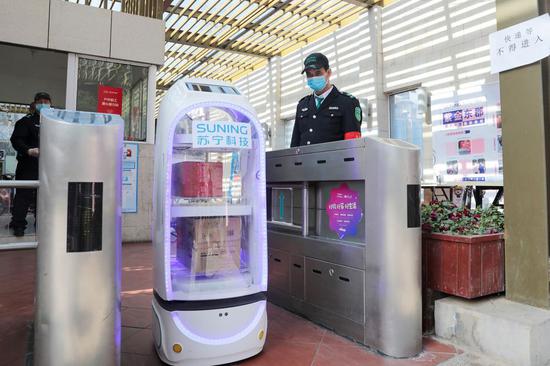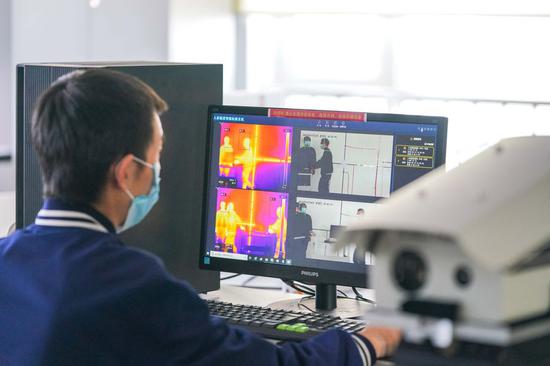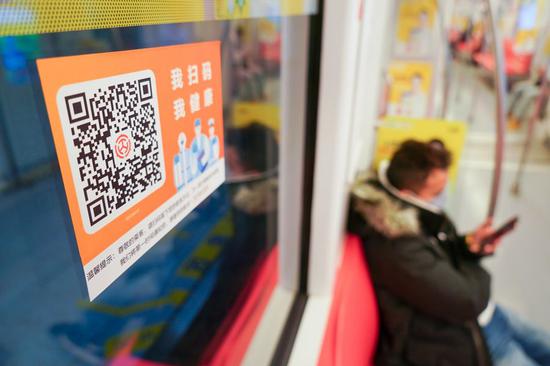
A smart mobile robot, with functions like facial recognition and temperature screening, patrols at an administrative service center in Suzhou, east China's Jiangsu Province, Feb. 21, 2020. (Xinhua)
From 5G robots, 3D-printed supplies to far-reaching medical advances, China has tackled the novel coronavirus with its tech prowess, which is proven effective as more promising signs signal progress in the country's anti-virus fight.
Cute, swift robots delivering packages, AI-backed voice assistants and unmanned drones with a loudspeaker reminding people to wear masks are no longer confined to the realm of science fiction, as they are actually taking place across China.
A smart mobile robot, with functions like facial recognition and temperature screening, has been patrolling in the city of Suzhou, east China's Jiangsu Province, to help control the spread of the coronavirus.
Featured with technologies of 5G, cloud computing and intelligent vision, the robot can simultaneously track more than 30 people, according to the Suzhou Innovation Research Institute of Nanjing University, one of its developers.
"The robot can tell whether people are wearing masks. And if not, it will beep and give a verbal reminder," said Chen Jie, a researcher with the institute.
In Nanjing, capital city of Jiangsu, robots are replacing deliverymen during the epidemic. Launched by leading Chinese e-commerce company Suning.com, the robots are utilized to complete door-to-door deliveries as many neighborhoods have restricted access after the virus outbreak.
According to Suning, the robot has a maximum loading capacity of 145 liters and will be disinfected after each delivery. With a positioning accuracy of fewer than 50 mm, it can map out delivery routes and avoid obstacles, working for up to 10 hours on a charge.
The robot has also played its part in the city of Wuhan, the epicenter of the epidemic, by delivering urgent medical supplies and daily necessities after the city implemented strict traffic restrictions.
The deployment of cutting-edge technologies in the battle against the coronavirus has been very opportune, said Michael Walsh, chief executive of the Pacific Basin Economic Council when interviewed by China Daily last month.
Such a public health emergency has taught the world how effective technologies can be in offering humanitarian relief, he added.
Bruce Aylward, team leader of the China-World Health Organization (WHO) joint mission on the coronavirus, said he was impressed by China's pragmatic, systemic and innovative approach to control the outbreak after his nine-day field study trip in the country.

A robot of leading Chinese e-commerce company Suning.com delivers goods at a residential area in Nanjing, east China's Jiangsu Province, Feb. 10, 2020. (Xinhua)
FRONTLINE MARVELS
After the outbreak, the Suzhou Jiangnan Aerospace Mechanical and Electric Industry Co., Ltd. immediately mobilized nine sets of "mobile hospital" equipment to aid the makeshift hospitals in Wuhan.
The equipment consists of specialized vehicles that can support rescue workers in surgeries, telecommunications, electricity and other areas, according to the company.
To properly handle medical waste, a kind of mobile incineration cabin, with a size of three standard containers, is used in Wuhan, which can incinerate 5 tonnes of medical waste daily, burning waste into harmless ashes within 20 minutes, said the developer Nanjing Luzhou Machine Co., Ltd.
3D-printed quarantine rooms are also cutting an eye-catching figure on the front line in hardest-hit Hubei Province. The rooms of about 10 square meters each are well-equipped with an air-conditioner, bathroom and shower facilities for patients under quarantine, according to its developer, a materials company based in Suzhou.
Tech companies across China have been devoted to product innovation amid the virus outbreak. A research and development team from Harbin Xinguang Optic-Electronics Technology Co., Ltd. only spent five days in inventing a new type of spectrum thermometer.
"The thermometer can detect abnormal body temperatures within a 30-meter radius in less than one second," said Qu Bo, deputy general manager of the Heilongjiang-based company, adding that they are operating in full swing to ensure the supplies of epidemic prevention materials.

A technician of the Harbin Xinguang Optic-Electronics Technology Co., Ltd. adjusts the spectrum thermometer in Harbin, northeast China's Heilongjiang Province, March 13, 2020. (Xinhua/Wang Song)
MEDICAL SOLUTIONS
Chinese scientists are racing to make scientific and technological breakthroughs, said Ding Xiangyang, deputy secretary-general of the State Council, noting that the country has adopted treatment methods that combine traditional Chinese medicine and Western medicine.
Nucleic acid testing is playing an important role in coronavirus detection. Experts in Jiangsu's Wuxi have developed a rapid nucleic test kit, which can screen the infection within 15 minutes, according to a biotech company in the city.
A total of 14 products for testing the virus have been approved for clinical use, according to Wu Yuanbin, director-general of science and technology for social development with the Ministry of Science and Technology, at a press conference on March 6.
"Nucleic acid testing can detect the gene sequence of the virus and China's sequencing technical capabilities have proved to be among the best in the world, as the gene of the coronavirus was successfully sequenced in just one week after the outbreak," said Tammy Tan, founder of a biotech company in Jiangsu.
Vaccines are also being developed at a rarely seen speed in China. Some vaccines against the coronavirus are expected to enter clinical trials in April, according to Zheng Zhongwei, director of the Development Center for Medical Science and Technology of the National Health Commission.
Zheng said the research and development of vaccines are carried out according to laws and technical requirements, and Chinese researchers have maintained exchanges with the WHO on the standard of vaccines.
"Our goal is to release the vaccine as soon as possible while ensuring its safety and effectiveness," he added.

Photo taken on Feb. 20, 2020 shows a QR code for passengers to register their information and trace back their travel routes in a subway train in Nanjing, east China's Jiangsu Province. (Xinhua/Li Bo)

- Wider vaccination helps China build immune barrier against coronavirus
- U.S. targeting China on coronavirus tracing ‘a global open secret’
- Coronavirus more likely to be product of nature than of lab
- High-tech machines help rice spring plowing in Guangxi
- Homegrown vaccines withstand coronavirus variants
- Confirmed coronavirus case reported in Shanghai
Popular Videos
Hot comments
- First apes at U.S. zoo receive COVID-19 vaccine made for animals, zoo official says
- China Life: Chinese women shine with She Power
- Foreign firms approved to offer VPN services in capital
- Homemade curling videos trending in China
- 86-year-old grandma in Hebei spends most her life on traditional cheongsam
- Winners of 2022 Inaugural WLA Prize announced
- Lantern Festival: A romantic celebration in China
- Two Chinese COVID-19 vaccine firms to supply vaccines to COVAX
- Media center for 20th CPC national congress to open on Oct. 12
- Six suspects arrested in HK for role in SE Asia job scam
Top Reviews
- Young artists recreate beauty of traditional Hanfu costume
- China releases photos of tallest tree
- English version of ‘Understanding Xi Jinping’s Educational Philosophy’ published
- China crowned in men’s team for 10th straight time at table tennis worlds
- China publishes Atlas of Wildlife in SW China
- Guangxi’s 10 Years: A Visit to China’s Qinzhou Port
- Congress delegate helped lift village out of poverty
- Expo highlights joint efforts in NEV development
- Racism stain of shame on ‘world democratic paradise’
- U.S. may face new COVID wave this upcoming winter: report







